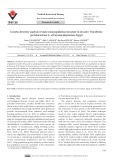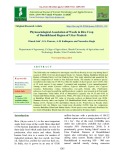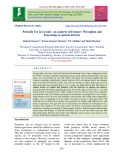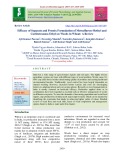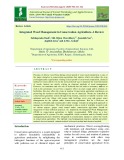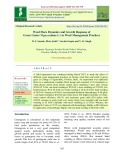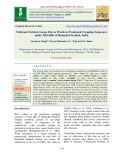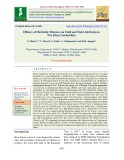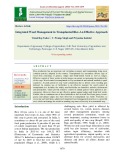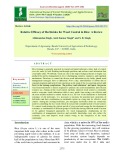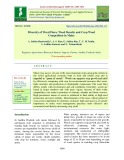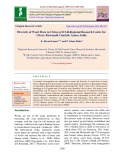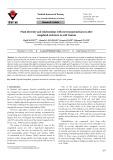
Weed diversity
-
Weed identification helps ensure crop yield and realize precision agriculture. Although the deep learning-based methods have achieved high performance, their needed large-scale annotated data is difficult to obtain, and the massive parameters lead to difficulties in model deployment in embedded applications. To develop efficient crop weeds classification system, we propose a dissimilarity-based method to select few but representative samples and consider data diversity.
 12p
12p  lyhuyenthu
lyhuyenthu
 31-01-2023
31-01-2023
 10
10
 3
3
 Download
Download
-
Worldwide feralization of crop species into agricultural weeds threatens global food security. Weedy rice is a feral form of rice that infests paddies worldwide and aggressively outcompetes cultivated varieties. Despite increasing attention in recent years, a comprehensive understanding of the origins of weedy crop relatives and how a universal feralization process acts at the genomic and molecular level to allow the rapid adaptation to weediness are still yet to be explored.
 11p
11p  viarchimedes
viarchimedes
 26-01-2022
26-01-2022
 11
11
 0
0
 Download
Download
-
Trianthema portulacastrum L. (Aizoaceae) is a common weed associated with cultivated crops. It is an exotic weed that originated in South Africa and is spreading all over the world. Thirty-five accessions were collected from six populations at Fayoum depression (FD), Egypt. Molecular analyses of start codon targeted (SCoT) markers were performed to identify genotypic variation among collected populations. The effectiveness of employing SCoT markers was demonstrated by the high percentage of polymorphisms.
 15p
15p  langthannam
langthannam
 29-12-2021
29-12-2021
 16
16
 0
0
 Download
Download
-
This study was conducted to provide data on the weed species composition of the Cyperaceae and Poaceae in the rice fields in An Giang province. The study results show that the weed species composition of Cyperaceae and Poaceae families is very diverse with 38 species belonging to 25 genera, of which 27 are usable. The largest number of species is in crop 1 and in the fields inside the ring dike.
 11p
11p  viwilliamleiding
viwilliamleiding
 10-12-2021
10-12-2021
 7
7
 1
1
 Download
Download
-
Genetic diversity within a species reflects population evolution, ecology, and ability to adapt. Genome-wide population surveys of both natural and introduced populations provide insights into genetic diversity, the evolutionary processes and the genetic basis underlying local adaptation. Grass carp is the most important freshwater foodfish species for food and water weed control.
 16p
16p  visilicon2711
visilicon2711
 20-08-2021
20-08-2021
 12
12
 1
1
 Download
Download
-
The field study was conducted to investigate weed flora diversity in rice crop during kharif season of 2020-21 in four development blocks viz. Naraini, Mahua, Badokhar Khurd and Baberu of Banda District in Uttar Pradesh State. This study identified and quantified the floristic composition of weeds in four different blocks. The number of monocot species recorded in the study was 13 (68 %), while the number of dicot species was 6 (32%). Out of 19 weed species 9 were annual...
 10p
10p  chauchaungayxua11
chauchaungayxua11
 23-03-2021
23-03-2021
 12
12
 2
2
 Download
Download
-
In agriculture, the use of pesticide has been the dominant form of pest management since the 1950s to kill pest organisms including insects, weeds, fungi and nematodes. In recent times, use of pesticides in rice and wheat cultivation has increased rapidly and this scenario contributes significantly towards adverse effects on human health, environment and on overall bio-diversity as these two crops are among the major food crops grown in India and study area.
 9p
9p  gaocaolon9
gaocaolon9
 22-12-2020
22-12-2020
 17
17
 1
1
 Download
Download
-
Weeds are considered as a source of new viruses and reservoirs of unidentified economically important viruses but are often neglected during diversity studies. Here, the weeds which are highly susceptible for the virus infection found in the Pulse Research block of Tamil Nadu Agricultural University, Coimbatore is documented. Many scientific reports have demonstrated that weeds serve as reservoir or alternative hosts for begomovirus survival and spread in the absence of the main crops. Now some new weeds are also added to the list in transmitting virus and host for vector.
 4p
4p  trinhthamhodang9
trinhthamhodang9
 16-12-2020
16-12-2020
 13
13
 2
2
 Download
Download
-
India has a wide range of agro-climates regions and soil types. The highly diverse agriculture systems are beset with different types of weed problem. Weeds cause 10- 80% crop yield losses besides deteriorating quality of products and causing health and environmental hazards. Traditionally, weed control has been largely dependent on manual weeding.
 15p
15p  chauchaungayxua8
chauchaungayxua8
 03-10-2020
03-10-2020
 11
11
 1
1
 Download
Download
-
Review study showed that CTPTR-CTW and ZTDSR-ZTW (RRRW) record the highest seed bank (SB) of grasses, sedges and BLWs as total weeds, in general; and predominant weeds i.e., Echinochloa spp., Ammania baccifera, Commelina benghalensis and Digitaria sanguinalis, in particular. It also showed the higher species richness (DMg) and Shannon–Weaver (H’) indices. CTDSRCTW and CTDSR-ZTW (RRR) show the lowest WSB and at par with Shannon–Weaver (H’) index; further, lowest species richness (DMg) under CTDSR-CTW.
 15p
15p  caygaocaolon7
caygaocaolon7
 18-09-2020
18-09-2020
 11
11
 2
2
 Download
Download
-
Presence of diverse weed flora during critical period of crop-weed competition, is one of the major obstacles in conservation agriculture that reduces which can reduce the crop yield appreciably significantly. During critical period of crop-weed competition, chemical method of weed control is by far the most preferred way to minimize the weed infestation of weeds, farmers are mostly relying on chemical methods of weed management.
 14p
14p  caygaocaolon7
caygaocaolon7
 18-09-2020
18-09-2020
 13
13
 2
2
 Download
Download
-
A field experiment was conducted during Kharif 2017 to study the effect of different weed management practices on diverse weed flora and yield of green gram at College of Agriculture, Gwalior, India.
 6p
6p  angicungduoc6
angicungduoc6
 22-07-2020
22-07-2020
 8
8
 1
1
 Download
Download
-
The present study was carried out in a continuing experiment at the Bhadiarkhar farm of the CSK HPKV. Eight cropping sequences [C1- ‘rice – wheat’, C2- ‘rice – pea – summer squash’, C3- ‘okra – radish – onion’, C4- ‘turmeric – pea – summer squash’, C5- ‘rice – lettuce – potato’, C6- ‘rice – palak – cucumber’, C7- ‘rice – broccoli – radish’, C8- ‘colocasia – pea + coriander’] were evaluated during 2016-17. There were 24 weed species which invaded different cropping systems. During kharif, Ageratum sp. (28%), Cynodon dactylon (20%) and Commelina benghalensis (19%) were the predominant weeds.
 7p
7p  angicungduoc5
angicungduoc5
 14-06-2020
14-06-2020
 5
5
 0
0
 Download
Download
-
Direct seeded rice having weed diversity in a substantial amount and the use of single herbicide for weed management is ineffective to control the wide range of weed hence chances of weed flora shift and herbicide resistance in weeds is expected. So to study the efficacy of herbicide mixtures in wet direct seeded rice, an experiment was conducted at Institute Research Farm of ICAR-National Rice Research Institute, Cuttack (Odisha) during kharif season of 2017.
 6p
6p  trinhthamhodang5
trinhthamhodang5
 16-05-2020
16-05-2020
 13
13
 1
1
 Download
Download
-
Rice production has an important role in Indian economy and transplanting being most common practice adopted in the country. Transplanted rice encounters diverse type of weed flora consisting of grasses, sedges and broad-leafed weeds as well as sedges. Effective control of these weeds at initial stages can ensure in increasing the productivity of this crop. Weed control in transplanted rice by mechanical and cultural methods is quiet expensive. At peak period of crop weed competition due to labour crises weeding gets delayed.
 10p
10p  nguathienthan4
nguathienthan4
 18-04-2020
18-04-2020
 21
21
 1
1
 Download
Download
-
Rice farming is generally practiced in warm/cool humid subtropics where lack of control over the water by both flooding and drought problems and serious weed infestation thus crop badly suffer. Worldwide, weeds are one of the major biological threats to higher rice productivity and its management in rice is challenging, complex, expensive, and regulated mechanism. Therefore, to control the diverse weed infestation in rice fields, planed weed management strategies have to addressed.
 8p
8p  chauchaungayxua4
chauchaungayxua4
 18-03-2020
18-03-2020
 17
17
 0
0
 Download
Download
-
Maize (zea mays l.) Is one of the most important crops among the cereals in the world agricultural economy both as food and fodder crop and is regarded as “queen of cereals”. Weeds can suppress crop growth and yield by effectively competing with crop for environmental resources like water, light, nutrients and production of allelopathic compounds. The weed flora differs widely with environment and soil conditions. Generally, weeds are found in larger numbers and with more vigour, because of their wider adaptability even under extremities of climatic, edaphic and biotic stresses.
 12p
12p  nguaconbaynhay3
nguaconbaynhay3
 07-02-2020
07-02-2020
 12
12
 0
0
 Download
Download
-
A systemic investigation was undertaken to assess the diversity of weed flora in citrus farm of Regional Research Centre for Citrus and inside the premises of Biswanath College of Agriculture, Biswanath Chariali, Assam during 2017-2018. A total of 134 weeds species belonging to 103 genera and 34 families were identified. Out of these, 104 species were dicotyldones and 30 species were monocotyldones. Among the 34 identified families, 9 families viz.
 8p
8p  quenchua2
quenchua2
 15-12-2019
15-12-2019
 17
17
 1
1
 Download
Download
-
On a broad scale, the extent of clearing and plowing of the crops in rangelands has brought a significant degradation in pasture species along with an invasion of weed species. This work evaluates the vegetation composition of an agriculture field after 15 years of exclosure and protection against clearing and plowing activities.
 11p
11p  vikimsa
vikimsa
 22-02-2019
22-02-2019
 9
9
 0
0
 Download
Download
-
An organic farm plan is central to the certification process. The farm plan describes production, handling, and record-keeping systems, and demonstrates to certifiers an understanding of organic practices for a specific crop. The process of developing the plan can be valuable in terms of anticipating potential issues and challenges, and fosters thinking of the farm as a whole system. Soil, nutrient, pest, and weed management are all interrelated on organic farms and must be managed in concert to be successful.
 24p
24p  loginnhanh
loginnhanh
 25-04-2013
25-04-2013
 59
59
 5
5
 Download
Download
CHỦ ĐỀ BẠN MUỐN TÌM











